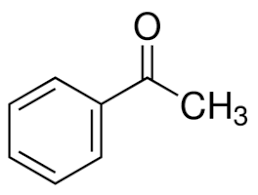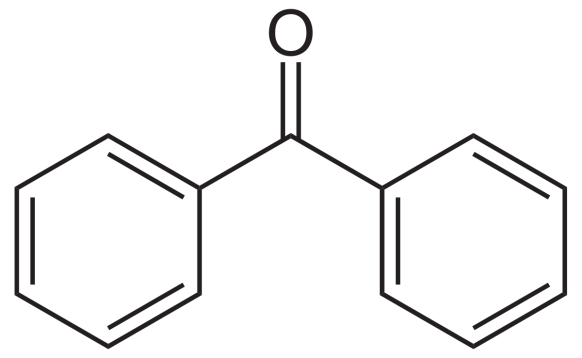
Acetophenone and benzophenone can be distinguished by which of the following tests?
A.Knoevenagel reaction
B.Cannizzaro's reaction
C.Aldol condensation
D.HVZ reaction
Answer
214.8k+ views
Hint: For this question we need the reactants required for the above name reaction. Acetophenone has one benzene ring and benzophenone has two benzene rings. Both are ketonic in nature but the difference is one has alpha hydrogen and the other one does not have alpha hydrogen.
Complete step by step solution:
Aldehydes and ketones with at least 1 alpha hydrogen, when reacted with alkali, form beta hydroxy aldehyde or ketones respectively. The above reaction is known as Aldol condensation. The beta hydroxy aldehydes are called aldol and beta hydroxy ketones are called keto products.
Alpha hydrogen is that hydrogen which is directly attached to carbon next to the carbonyl group called alpha carbon. The structure of acetophenone is:

As we can see from the structure, the carbon on the right hand side of carbonyl has 3 alpha hydrogen’s directly attached to carbon next to carbonyl carbon. The left hand side has no hydrogen on adjacent carbon. So acetophenone will give an aldol test.
Now let us look at the structure of benzophenone:

The carbon adjacent to carbonyl carbon (called alpha carbon) has no hydrogen atoms. Hence the above will not give the test for alcohol condensation. So we can distinguish acetophenone and benzophenone by aldol reaction.
So the correct option is C.
Note: In Knoevenagel reaction, the reactants are active methylene compounds whereas in cannizaro reaction, only one reactant is either aldehyde or ketone disproportionate. HVZ is the Hell Volhard Zelinsky reaction which has halogenated carboxylic acids as one of the reactants. So all these options stand eliminated.
Complete step by step solution:
Aldehydes and ketones with at least 1 alpha hydrogen, when reacted with alkali, form beta hydroxy aldehyde or ketones respectively. The above reaction is known as Aldol condensation. The beta hydroxy aldehydes are called aldol and beta hydroxy ketones are called keto products.
Alpha hydrogen is that hydrogen which is directly attached to carbon next to the carbonyl group called alpha carbon. The structure of acetophenone is:

As we can see from the structure, the carbon on the right hand side of carbonyl has 3 alpha hydrogen’s directly attached to carbon next to carbonyl carbon. The left hand side has no hydrogen on adjacent carbon. So acetophenone will give an aldol test.
Now let us look at the structure of benzophenone:

The carbon adjacent to carbonyl carbon (called alpha carbon) has no hydrogen atoms. Hence the above will not give the test for alcohol condensation. So we can distinguish acetophenone and benzophenone by aldol reaction.
So the correct option is C.
Note: In Knoevenagel reaction, the reactants are active methylene compounds whereas in cannizaro reaction, only one reactant is either aldehyde or ketone disproportionate. HVZ is the Hell Volhard Zelinsky reaction which has halogenated carboxylic acids as one of the reactants. So all these options stand eliminated.
Recently Updated Pages
Chemical Equation - Important Concepts and Tips for JEE

JEE Main 2022 (July 29th Shift 1) Chemistry Question Paper with Answer Key

Conduction, Transfer of Energy Important Concepts and Tips for JEE

JEE Analytical Method of Vector Addition Important Concepts and Tips

Atomic Size - Important Concepts and Tips for JEE

JEE Main 2022 (June 29th Shift 1) Maths Question Paper with Answer Key

Trending doubts
JEE Main 2026: Application Form Open, Exam Dates, Syllabus, Eligibility & Question Papers

JEE Main Correction Window 2026 Session 1 Dates Announced - Edit Form Details, Dates and Link

Equation of Trajectory in Projectile Motion: Derivation & Proof

JEE Main 2026 Application Login: Direct Link, Registration, Form Fill, and Steps

Hybridisation in Chemistry – Concept, Types & Applications

Angle of Deviation in a Prism – Formula, Diagram & Applications

Other Pages
NCERT Solutions For Class 12 Chemistry Chapter 1 Solutions - 2025-26

NCERT Solutions for Class 12 Chemistry Chapter Chapter 7 Alcohol Phenol and Ether

NCERT Solutions ForClass 12 Chemistry Chapter Chapter 8 Aldehydes Ketones And Carboxylic Acids

JEE Advanced Marks vs Ranks 2025: Understanding Category-wise Qualifying Marks and Previous Year Cut-offs

Haloalkanes and Haloarenes Class 12 Chemistry Chapter 6 CBSE Notes - 2025-26

Solutions Class 12 Chemistry Chapter 1 CBSE Notes - 2025-26




